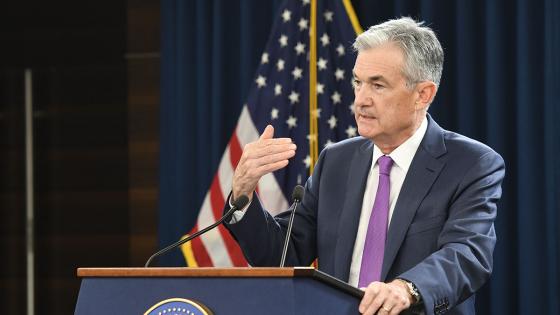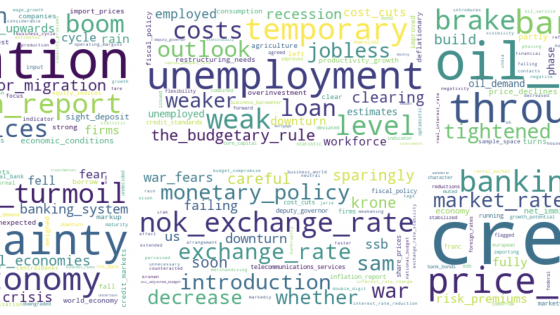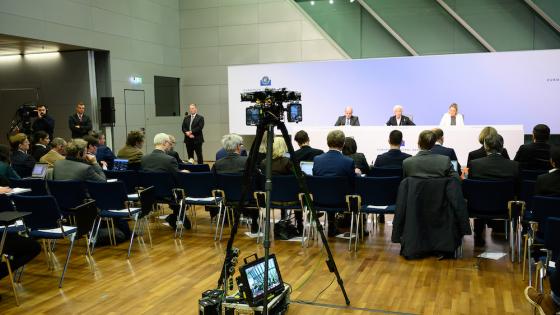In a famous analysis, Mehrabian (1971) posited a 7-55-38 rule of communication: words convey 7% of a message, body language (gestures, facial expressions, etc.) accounts for 55%, and tone delivers 38%. While the debate on exact percentages for each channel is far from settled, it is clear that effective communication has to rely on more than just the text. Central banks have been increasingly relying on communication-based tools (e.g. forward guidance) to manage the public’s expectations, but do central bankers utilise communication to its full potential?
It has been widely documented that the content and text sentiment of statements, minutes, and transcripts can move financial markets (e.g. Hansen and McMahon 2016, Hansen et al. 2018). However, little is known about the effects of central bankers’ non-verbal communication. In a recent study (Gorodnichenko et al. 2021), we develop a novel deep learning model to quantify tone (vocal emotions) embedded in the answers given by Federal Reserve (Fed) chairs during Federal Open Market Committee (FOMC) press conferences over the period 2011 to June 2019. In other words, we move beyond text analysis and study how policy messages are voiced. We then examine whether emotions in voice tone can move financial markets.
Vocal and verbal features of monetary policy communication
Building on recent research on voice recognition and speech emotion, we develop a neural network algorithm to classify the emotions embedded in the answers during FOMC press conferences. Specifically, we split a given press conference into audio segments corresponding to each question raised during the event and the response of the speaker. The split audios are then run through a machine learning procedure which is trained to recognise emotions from voice variations. Each answer is rated in terms of three emotions: positive (happy or pleasantly surprised emotions), negative (sad or angry emotions), and neutral. For a given press conference, the aggregate voice tone is then measured as the ratio of the difference between the positive answers and the negative answers to the total number of positive and negative answers.
On average, Ben Bernanke had more positive emotions in his voice than Janet Yellen, who in turn had generally more positive emotions in her voice than Jerome Powell. Bernanke had five Q&A sessions with only positive emotions in his voice. In contrast, Jerome Powell had five Q&A sessions with only negative emotions. Janet Yellen’s sessions always had a mix of positive and negative emotions. Moreover, there is a considerable within-speaker variation in the tone, with Jerome Powell exhibiting the largest variation.
We also employ a dictionary-based approach similar to Neuhierl and Weber (2019) to classify the text of statements and press conference transcripts into hawkish versus dovish sentiment. The sentiment of texts during the terms of Bernanke and Yellen appeared to be more dovish than Powell’s, which likely reflects that policy rate increases dominated during Powell’s period in our sample. The within-speaker variation in the text sentiment is broadly similar across the Fed chairs. Additionally, the variation in text sentiment during Q&A sessions is larger than the variation in the text sentiment for statements and remarks, which is likely a result of the less scripted nature of Q&A sessions relative to other communication types.
Co-movement in voice, word, and policy actions
Although one might think that text and voice should be highly congruent, we find that the relationship between these two channels of communication is more nuanced. Specifically, the positive messages conveyed in the voice tone are associated with more dovish texts, but this relationship is fairly weak. In fact, it is not uncommon to observe dovish texts and negative tonality. Similarly, there is only a weak correlation between the variation in tone and actual policy shocks identified as in Swanson (2020): a shock to the policy rate (FFR shock), a forward guidance (FG) shock, or an asset purchase (AP) shock. However, there is a stronger correlation between voice tone and the stage of the policy cycle measured by the shadow rate (Wu and Xia 2016). In short, the tone of Q&A responses may generate variation in policy communication that is unrelated to the Fed’s actions and verbal communication.
Fed chairs’ voice tone and financial markets
Using local Jordà (2005) projections, we show that a more positive voice tone leads to an increase in share prices (Figure 1). Specifically, the contemporaneous response of the stock market is weak and not significant statistically. Over time, the response builds up and after five days, the return on SPY ETF reaches approximately 100 basis points for a unit increase in voice tone. Importantly, the magnitude of the stock market response to a unit decrease in voice tone is approximately equal to the response we observe after a one-standard-deviation forward-guidance shock. Thus, the variation in voice tone has economically significant effects on the stock market.
Figure 1 Response of SPY ETF (S&P 500) to policy actions and messages.
Notes: The figure reports estimated slope coefficients for policy communication/actions. Dashed lines show 90% bootstrap confidence intervals. FFR, FG, and AP shocks are normalised to have unit variance.
Further examination suggests that a positive voice tone tends to decrease current and anticipated volatility (Figure 2), which is consistent with the notion that central banks can shape uncertainty about future economic conditions (Hansen et al. 2019). A more positive tone also leads to a reduction in investors’ expectation about interest rate risk.
Figure 2 Response of VIX (CBOE volatility index) to policy actions and messages.
Notes: The figure reports estimated slope coefficients for policy communication/actions. Dashed lines show 90% bootstrap confidence intervals. FFR, FG, and AP shocks are normalised to have unit variance.
In contrast to the strong responses of the stock market, bond market tends to take few vocal cues from the Fed chairs (Figure 3). This finding is consistent with Cieslak and Pang (2020) or Ehrmann and Talmi (2020), who document that bond market reaction to Fed communications is weak. By examining the response of the spread between nominal and inflation-indexed government bonds, we find that a more positive voice tone leads to lower expected inflation after five to ten days. One may conjecture that positive tone plays a signalling role: a happy tone of the Fed chair indicates satisfaction with future inflation dynamics.
Figure 3 Response of LQD ETF (corporate debt) to policy actions and messages.
Notes: The figure reports estimated slope coefficients for policy communication/actions. Dashed lines show 90% bootstrap confidence intervals. FFR, FG, and AP shocks are normalised to have unit variance.
Why does voice tone matter?
Overall, our findings show that just as the actions of the Fed move financial markets so too does the vocal aspect of FOMC press conferences. One potential explanation is that due to asymmetric information between the public and the central bank, market participants tend to look for more information through the aspects which are not explicitly ‘scripted’ such as the voice tone or body language of the Fed chair. These non-verbal elements of communication can signal the Fed’s perspective on current/future economic outlook and/or the course of future monetary policy. In fact, it is not uncommon that investors and media watch/listen to the FOMC press conference, analyse the chair’s voice, and attempt to interpret what it (i.e. the voice tone/emotion) means. In other words, the press and financial market investors appear to pay attention to the non-verbal communication.
Although future work should dig deeper into understanding nuances of using voice to communicate policy, our results clearly have important policy implications. How messages are said appears to be potentially as important as what is in the messages. This does not make the job of central bankers easier and possibly adds another qualification (voice control) to the job requirement. However, this could be a prerequisite for anybody interested in using a public arena for policy communication. Indeed, to paraphrase Ronald Reagan, how can a Fed chair not be an actor?
References
Cieslak, A and H Pang (2020), “Common shocks in stocks and bonds”, NBER Working Paper No. w28184.
Ehrmann, M and J Talmi (2020), “Starting from a blank page? Semantic similarity in central bank communication and market volatility”, Journal of Monetary Economics 111: 48-62.
Gorodnichenko, Y, T Pham and O Talavera (2021), “The Voice of Monetary Policy”, CEPR Discussion Paper 15932.
Hansen, S and M McMahon (2016), “Shocking language: Understanding the macroeconomic effects of central bank communication”, Journal of International Economics 99: S114-S133.
Hansen, S, M McMahon and A Prat (2018), “Transparency and deliberation within the FOMC: a computational linguistics approach”, Quarterly Journal of Economics 133(2): 801-870.
Hansen, S, M McMahon and M Tong (2019), “The long-run information effect of central bank communication”, Journal of Monetary Economics 108(C): 185-202.
Jordà, Ò (2005), “Estimation and Inference of Impulse Responses by Local Projections”, American Economic Review 95(1):161-182.
Mehrabian, A (1971), Silent Messages: Implicit Communication of Emotions and Attitudes, Belmont, CA: Wadsworth, p.30.
Neuhierl, A and M Weber (2019), “Monetary policy communication, policy slope, and the stock market”, Journal of Monetary Economics 108(C): 140-155.
Swanson, E T (2020), “Measuring the Effects of Federal Reserve Forward Guidance and Asset Purchases on Financial Markets”, Journal of Monetary Economics, In Press.
Wu, J C and F D Xia (2016), “Measuring the Macroeconomic Impact of Monetary Policy at the Zero Lower Bound”, Journal of Money, Credit and Banking 48(2-3): 253-291.









